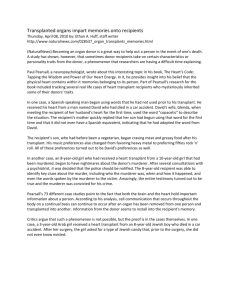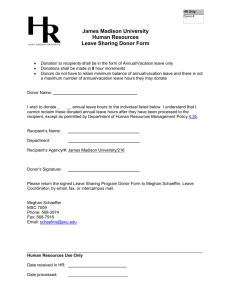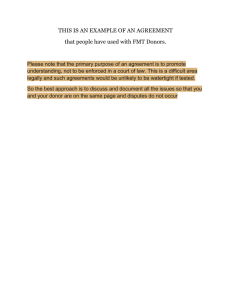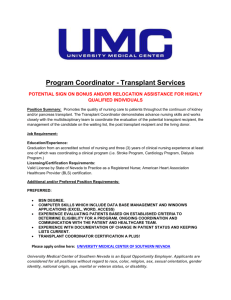Recip of High Risk Donors
advertisement
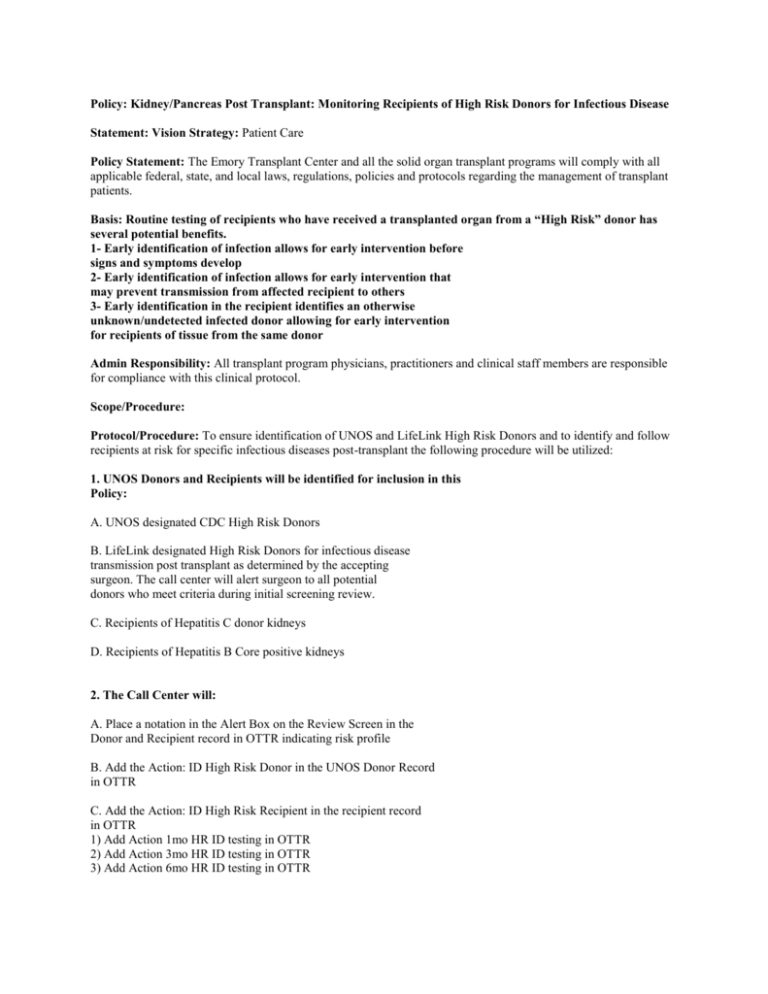
Policy: Kidney/Pancreas Post Transplant: Monitoring Recipients of High Risk Donors for Infectious Disease Statement: Vision Strategy: Patient Care Policy Statement: The Emory Transplant Center and all the solid organ transplant programs will comply with all applicable federal, state, and local laws, regulations, policies and protocols regarding the management of transplant patients. Basis: Routine testing of recipients who have received a transplanted organ from a “High Risk” donor has several potential benefits. 1- Early identification of infection allows for early intervention before signs and symptoms develop 2- Early identification of infection allows for early intervention that may prevent transmission from affected recipient to others 3- Early identification in the recipient identifies an otherwise unknown/undetected infected donor allowing for early intervention for recipients of tissue from the same donor Admin Responsibility: All transplant program physicians, practitioners and clinical staff members are responsible for compliance with this clinical protocol. Scope/Procedure: Protocol/Procedure: To ensure identification of UNOS and LifeLink High Risk Donors and to identify and follow recipients at risk for specific infectious diseases post-transplant the following procedure will be utilized: 1. UNOS Donors and Recipients will be identified for inclusion in this Policy: A. UNOS designated CDC High Risk Donors B. LifeLink designated High Risk Donors for infectious disease transmission post transplant as determined by the accepting surgeon. The call center will alert surgeon to all potential donors who meet criteria during initial screening review. C. Recipients of Hepatitis C donor kidneys D. Recipients of Hepatitis B Core positive kidneys 2. The Call Center will: A. Place a notation in the Alert Box on the Review Screen in the Donor and Recipient record in OTTR indicating risk profile B. Add the Action: ID High Risk Donor in the UNOS Donor Record in OTTR C. Add the Action: ID High Risk Recipient in the recipient record in OTTR 1) Add Action 1mo HR ID testing in OTTR 2) Add Action 3mo HR ID testing in OTTR 3) Add Action 6mo HR ID testing in OTTR 3. The Post Transplant Coordinator will: A. Place the recipient on the Watch List in OTTR B. Ensure that the recipient HR ID testing is reflected/reviewed on the 1mo, 3mo and 6mo tracking report/review C. Ensure that the recipient has the following HR ID testing at 1mo, 3mo, and 6mo HIV Quant Hep B DNA HCV Quant High Risk Behavior with or without Hep B or C X X Hep B Core Positive Donor Only X X Hep C Positive Donor Only X X X X X E. Schedule appointment for recipient with ID Team MD at 5-6 weeks post-transplant with above lab results available for review at this appointment. F. Add Action: Infectious Disease Consult in recipient OTTR record Indicated date scheduled and mark done when consult has been completed G. Each Lab Test: Obtain order, review results and enter into appropriate OTTR action then mark action done, review all positive findings immediately with ID team MD, and report out serial results at tracking meetings and clinical watch list review sessions References: 1- CDC Guidelines for Preventing Transmission of HIV Through Transmission of Human Organs and Tissue: May 1994 (Attach PDF here) 2- CDC Guidelines for High Risk Behavior (Attach PDF here) 3- UNOS Public Comment Document (Attach PDF here) Approved by: Renal (Pancreas) Transplant Leadership Group ___Signature on File_________________ Thomas C. Pearson, MD, DPhil Chair, Renal Transplant Leadership Group Director, Renal and Pancreas Transplant Programs Approval: 02/17/2010
